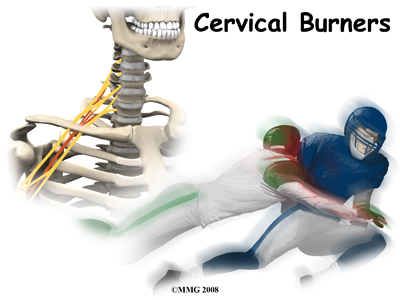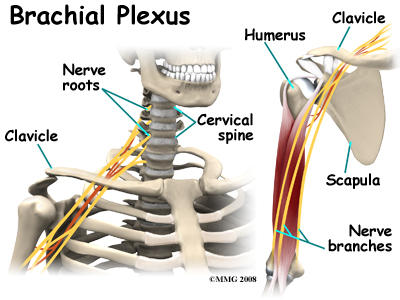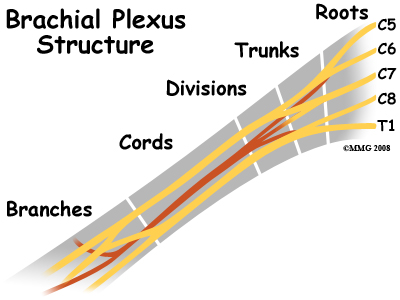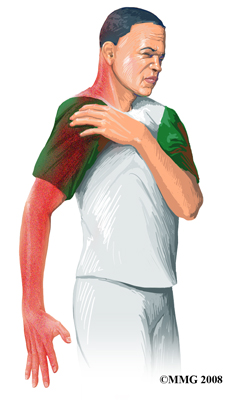Introduction
Physiotherapy in Bathurst for Upper Back and Neck

Welcome to Physio Max's patient resource about Cervical Burners and Stingers (Brachial Plexis Injuries).
Injury to the nerves of the neck and shoulder that cause a burning or stinging feeling are called burners or stingers. Another name for this type of nerve injury is brachial plexus injury. Football players are affected most often. Up to half of all college football players have had at least one burner or stinger. Many of these occurred during high school football. Fortunately, it’s not a serious neck injury.
This guide will help you understand:
- what parts of the body are involved
- how the problem develops
- how doctors diagnose the condition
- what treatment options are available
Anatomy
What parts of the body are involved?
The brachial plexus is affected most often by a downward or backward force against the shoulder. A nerve plexus is an area where nerves branch and rejoin. The brachial plexus is a group of nerves in the cervical spine from C5 to C8-T1. This includes the lower half of the cervical nerve roots and the nerve root from the first thoracic vertebra.

The nerves leave the spinal cord, go through the neck, under the clavicle (collar bone) and armpit, and then down the arm.
The brachial plexus begins with five roots that merge or join together to form three trunks.

The three trunks are upper (C5-C6), middle (C7), and lower (C8-T1).
Each trunk then splits in two, to form six divisions. These divisions then regroup to become three cords (posterior, lateral, and medial).

Finally, there are branches that result in three nerves to the skin and muscles of the arm and hand: the median, ulnar, and radial nerves.
Related Document: Physio Max's Guide to Cervical Spine Anatomy
Causes
What causes this condition?
Burners or stingers are the result of traction or compressive forces on the brachial plexus or cervical nerve roots. The usual mechanism of injury occurs when a direct blow or hard hit to the top of your shoulder pushes it down at the same time your head is forced to the opposite side.

In the process, the brachial plexus between the neck and shoulder gets stretched. The same injury can happen if a downward force hits the collarbone directly. In football, burners or stingers occur most often when you tackle or block another player. This motion overstretches the nerves of the brachial plexus.
It's not clear exactly where in the brachial plexus the damage occurs. Some experts suggest the injury is most likely to be at the level of the trunks, rather than at the nerve root level. The results of other studies show that burners or stingers from compression forces cause nerve root damage while traction injuries result in plexus injuries. A nerve root injury would be much more serious than a burner or stinger from a trunk injury of the brachial plexus.
Other athletes who participate in wrestling, gymnastics, snow skiing, and martial arts can also experience burners or stingers. Some studies suggest that athletes with a narrow cervical canal may be at increased risk for this type of injury.
Symptoms
What does this condition feel like?
A burning or stinging feeling between the neck and shoulder is the hallmark finding in this condition. True neck pain is more likely to be an injury to the neck itself. With burners or stingers, the painful symptoms start above the shoulder and go down the arm and even into the hand.

The shoulder and arm may feel numb or weak. You may feel as if this area is tingling. Weakness may be present at the time of the injury. Some patients report the arm feels and appears to be dead. This paralysis and other symptoms may be transient or temporary. They may only last a few seconds or minutes. But for some patients, healing takes days or weeks. In rare cases, the damage can be permanent.
Diagnosis
How do healthcare providers diagnose this condition?
A careful history and physical exam are needed to diagnose stingers or burners. When you first visit Physio Max, we begin by assessing areas of weakness. Our physiotherapist may be able to tell whether a stretch injury of the brachial plexus has occurred. Nerve function and reflexes are also evaluated.
If we suspect a cervical spine injury, you will be referred to a doctor for further diagnosis. Once your diagnostic examination is complete, the physiotherapists at Physio Max have treatment options that will help speed your recovery, so that you can more quickly return to your active lifestyle.
Physio Max provides services for physiotherapy in Bathurst.
Our Treatment
Burners and stingers are self-limiting. This means that with treatment, they will resolve over time. Rest and gentle neck and shoulder range of motion are advised until symptoms resolve. If this does not occur within a few days, then more intensive physiotherapy may be needed.
When you visit Physio Max, our physiotherapist will use modalities such as biofeedback, electrical nerve stimulation, and manual therapy to help restore the natural function of the nerves.
We will add range of motion and strengthening exercises as tolerated. Posture is very important during the healing phase. A chest-out position helps open the spinal canal, thus giving more room for the spinal cord. This posture also decreases pressure on the nerve roots. Our physiotherapist will provide sport-specific therapy when the symptoms resolve (go away).
You will likely be able to return to full sports participation when you no longer have any symptoms. Full neck and shoulder motion must be present, and you should be able to fully participate in practice without any problems before entering a game.
It is possible to get another burner or stinger but it could be something more serious. If you experience these types of symptoms again, slowly lie down on the ground. Wait for the team trainer or physician to examine you before moving your head and neck.
Some football players choose to wear extra padding, special shoulder pads, or a neck roll to protect the neck and avoid reinjury. All equipment should be in good condition and fit properly. Daily stretching of the neck is advised. Players should avoid using spearing or head tackling, which has been prohibited since 1979.
Physician Review
Protecting the neck with a soft collar is the first step in the acute phase of treating burners or stingers. If the injury occurred on the playing field, the player is placed in a protective collar before being moved off the field. This is worn until X-rays are taken to rule out fracture, dislocation, or other more serious neck injury.
Your doctor may use X-rays, MRI, and electrodiagnostic studies such as an electromyogram (EMG) to help make the final diagnosis. The EMG will confirm a problem, pinpoint the area of damage, and give an idea of how long recovery will take for each individual.
Surgery
Surgery is not a treatment option for burners or stingers. Management remains conservative (nonsurgical). Patients are followed through the athletic season until recovery is complete.
Portions of this document copyright MMG, LLC.






